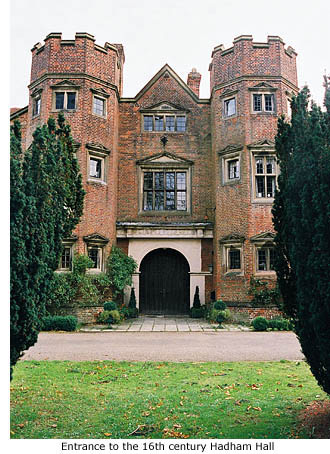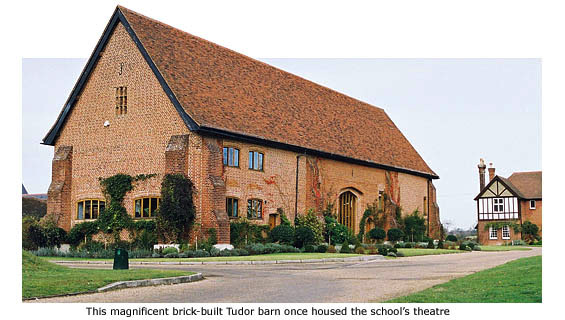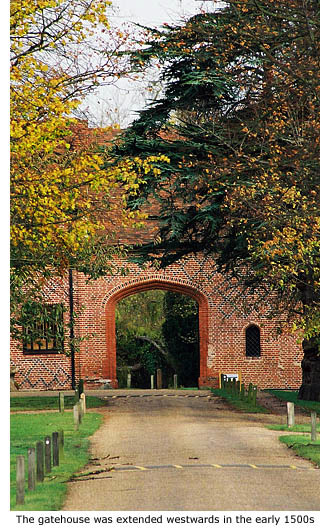|
 The site of Hadham Hall was first settled by the Catuvellauni, one of the Belgic tribes that led Celtic resistance to Julius Caeser’s invasion in 53 BC. During excavations here in 1962 a great deal of detail was revealed about how these early Britons lived, and many artifacts were found that prove they were a relatively prosperous people who took full advantage of the Roman way of life. However, the settlement appears to have been abandoned before the end of the 1st century AD when its inhabitants, probably encouraged by the Romans who conquered Britain in 43 AD, and who had a dislike for hill-top settlements, moved to the nearby valley settlements in Bishop’s Stortford and Braughing. The site of Hadham Hall was first settled by the Catuvellauni, one of the Belgic tribes that led Celtic resistance to Julius Caeser’s invasion in 53 BC. During excavations here in 1962 a great deal of detail was revealed about how these early Britons lived, and many artifacts were found that prove they were a relatively prosperous people who took full advantage of the Roman way of life. However, the settlement appears to have been abandoned before the end of the 1st century AD when its inhabitants, probably encouraged by the Romans who conquered Britain in 43 AD, and who had a dislike for hill-top settlements, moved to the nearby valley settlements in Bishop’s Stortford and Braughing.
The history of the manor of Hadham itself dates back to the 11th century when William, Bishop of London, owned it. At his death, in 1076, William the Conqueror made a grant of land in Hadham to William of Baud in Normandy, who had followed him to England at the time of the Conquest. His name is recorded in Domesday Book as Lord of Hadham.
He built the first Hadham Hall, along with barns and cattle sheds, on a 1–2 acre site surrounded by a stockade and moat. The house certainly wasn’t built on any grand scale, but as uncomfortable, cold and damp as it may have been, it served as the Baud’s manor house for 350 years. The only part to remain from that time is the causeway, built from soil extracted when the moat was dug.
By 1440, brick was taking the place of wood for house construction and Thomas Baud built a far more substantial manor house on the site of the original. Materials used were largely local products: timber from Livery Wood in Farnham and bricks manufactured in Bricklea field, which lays within the grounds to the north of Nut Walk. The second Hadham Hall stood for 130 years but all that remains now is the eastern section of its gatehouse, a barn and part of an old cottage.
In the late 15th century a number of social and economic changes took place in England that made it difficult for lords of small manors like Hadham. Much of the arable land was being converted to pasture and the mercantile classes were becoming affluent. Combined with the heavy taxes imposed by Henry VII to finance the war against France, the Baud family were forced to sell Hadham Hall along with its 980 acres of land. The long descent of family inheritance was finally at an end after almost 450 years.
The buyer of Hadham Hall was William Capel, the younger son of a Suffolk Squire who left his home at Stoke-by-Nayland in Suffolk to make his way in life by trade in London. And he certainly made his mark. Twice Lord Mayor of London, his success is also recorded in Capel Court near to the present day Stock Exchange, the former site of his London home built out of his vast wealth. He also owned an estate at Rayne, near Braintree in Essex, and it is probably because Stane Street (now the A120) made it easy to travel between Braintree and Hadham that he came to buy the Baud’s manor.
After his purchase in 1504 the Capels remained at their home in Rayne, but in the following 20 years extensive alterations to Hadham Hall were carried out including: extending the gatehouse further west; making an archway over which a clock tower was added; and building a large granary, now known as the Tudor barn. The gatehouse was subsequently used as a dwelling for farmhands. All of these additions to the house and grounds were constructed of bricks made in Bricklea field, the same site used for brick making by the Bauds when they built the second Hadham Hall. Excavations carried out in 1972 uncovered the kilns that were used, along with many Tudor bricks.
When William Capel died in 1515 he left the manor to his widow, Margaret. She resided there until her own death in 1522, at which time it was inherited by their son, Sir Gyles Capel (1486–1556). A good friend of Henry VIII, he was chosen to select the English Knights for jousting against the French at the Field of Cloth of Gold in June 1520. This was the name given to a meeting place near Calais where the entourage of Henry VIII and Francis I of France got together for a cordial meeting that included the entertainment of jousting.

The first member of the Capel family to actually live at Hadham Hall was Henry Capel (1537–1588) who moved in after his wife died in 1572. Between then and 1578 he had the second Hall demolished and built, partly on its foundations, the magnificent Elizabethan mansion that stands today. This is the same Hadham Hall in which Henry Capel entertained Queen Elizabeth I in 1578 when she lodged here while returning from Norfolk. The Queen passed through Bishop’s Stortford on her way to Hadham Hall and again on her return to London, and the event was duly recorded: ‘The Queen and her retinue came riding through the town from Little Hadham to great rejoicing, for 10s. (50p) was paid for Ringing to the Ringers when the Queens majesty came to mr Capells and from mr Capells thorowe the towne’.
The Elizabethan mansion comprised of three blocks: the north, west and south wings enclosing a large courtyard which was entered by archways in the west and south wings. Only the west wing and part of the south wing survive, but both arches are still visible.
In 1632 Hadham Hall was inherited by Arthur Capel, who made many additions and alterations to the property. These included the building of a Banqueting Hall that fully enclosed the courtyard to form a quadrangle, and an Italian garden. This he embellished with four fountains, classical statues, and a large terrace overlooking the deer park and woods. It was around this time that the Capel family portrait was painted by Cornelius Johnson and now hangs in the National Portrait Gallery, London.
In 1633 Arthur Capel bought nearby Wickham Hall Manor and its farm, and in 1640 became an MP for Hertfordshire. The crowning glory to his prosperity and nobility came in 1641 when Charles I made him Baron of Hadham. However, in the following years an ever-increasing divide between Charles I and Parliament eventually led to civil war and, ultimately, the end of Arthur Capel’s time at Hadham Hall.
The property then passed to his son, also Arthur, who lived in the house until 1668 when he moved to his mother’s estate at Cassiobury. There he led a busy and controversial political life but Hadham Hall soon fell into disrepair, possibly due to the cost of the Civil War or perhaps because of the Plague that raged in Bishop’s Stortford and the surrounding area at that time.
When Arthur Capel died in 1683, the deer were taken from Hadham Park to Epping Forest, the house was partly converted into a farmhouse and the estate itself divided up into three farms. The Banqueting Hall was then demolished and the building materials probably used to build two new farmhouses needed at Wickham Hall and Hadham Old Park Lodge. The Capel family retained the house during this time and in April 1698 entertained King William II to lunch on his return to London from the royal residence at Newmarket. Around 1720, that part of the building which remained was modernised in the Queen Anne style, and some rooms were reserved for the earl's own use when visiting his estate. Up until the start of the 20th century, Hadham Hall was farmed by a series of tenants including the Scott, Sworder and Betts families.
 Finally, in 1900, George Devereux de Vere Capel, the 8th Earl of Essex, sold the Hall and accompanying land, which by that time had more than doubled in acreage, to William Minet (1851–1933), a London merchant of French descent. Family tradition has it that in 1686 his ancestor, Issac Minet, a Huguenot, had fled religious persecution in France by rowing himself and his family across the channel to seek refuge in England. Like many Huguenots who escaped to England the Minets grew prosperous, and in 1770 Hughes Minet bought land in Camberwell and Lambeth. By the mid 1800s his London land had vastly increased in value and, by inheritance, eventually came to his great grandson, William. He bought Hadham Hall and the manor, along with records of its Courts from 1492 onwards and many other documents to do with its history. Using this information he set about restoring the existing buildings to their former state. Finally, in 1900, George Devereux de Vere Capel, the 8th Earl of Essex, sold the Hall and accompanying land, which by that time had more than doubled in acreage, to William Minet (1851–1933), a London merchant of French descent. Family tradition has it that in 1686 his ancestor, Issac Minet, a Huguenot, had fled religious persecution in France by rowing himself and his family across the channel to seek refuge in England. Like many Huguenots who escaped to England the Minets grew prosperous, and in 1770 Hughes Minet bought land in Camberwell and Lambeth. By the mid 1800s his London land had vastly increased in value and, by inheritance, eventually came to his great grandson, William. He bought Hadham Hall and the manor, along with records of its Courts from 1492 onwards and many other documents to do with its history. Using this information he set about restoring the existing buildings to their former state.
Two brick-built barns were left standing but wooden barns, cattle sheds and stables were demolished. Three new cottages (Stable Cottages) and a stable were built and a new north wing added to the mansion, albeit only half the length of its predecessor. Numerous alterations were carried our within the house and William Minet, who was his own architect, attempted to blend the restoration and rebuilding as closely as possible with the original. He did add his own mark by including the Minet cat – a French pun on his family name – in newly created niches on the outside of the building. A stain glass window was also added recording the family’s time spent at Hadham Hall. Although the grounds were occupied by troops in both World Wars, the house remained with the Minet family until 1948 when it was then sold to Hertfordshire County Council. They took the brave and experimental step of converting Hadham Hall into a co-educational school at a cost of £65,000.
Its catchment area was Bishop’s Stortford and the large rural community surrounding it, and in September 1952 it opened with 142 pupils. By June 1953 that number had increased to 172, including 14 boarders.
The school’s official opening was later that year on Friday 23 October, carried out by Mr David Carter, Chairman of the Hertfordshire branch of the National Farmers Union. In his speech he said he hoped that such an establishment would encourage pupils to follow rural and agricultural pursuits.
While still preserving the features of the old house, every part of Hadham Hall was utilised: the gatehouse providing storage and workshop accommodation for the school and its associated farming activities, while the tithe barn housed the school’s theatre and main assembly hall. The house itself became home for the headmaster and dormitories were created for the schools boarders. Classrooms within were oak panelled with beamed ceilings and additional modern, single storey classrooms were built in the grounds where livestock roamed freely. The once formal Italian garden was turned into a hockey pitch.
The school survived for 38 years until Hertfordshire County Council decided there were not enough children in the area to justify the expense of keeping it open. On Friday 20 July 1990 the school closed to merge with Margaret Dane school in Bishop’s Stortford and form the new Birchwood High (See Guide 10).
The listed house, out-buildings and 40 acres of land was then put on the market for £3 million.
Read former pupil Roland Jaggard's memories of Hadham Hall
|

